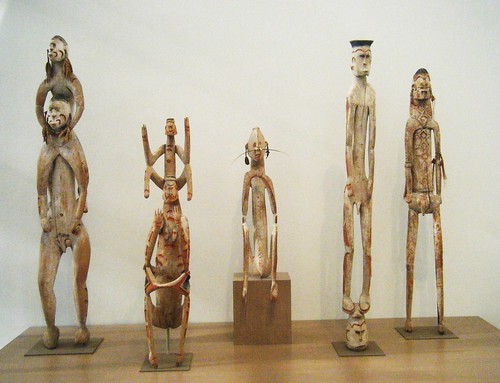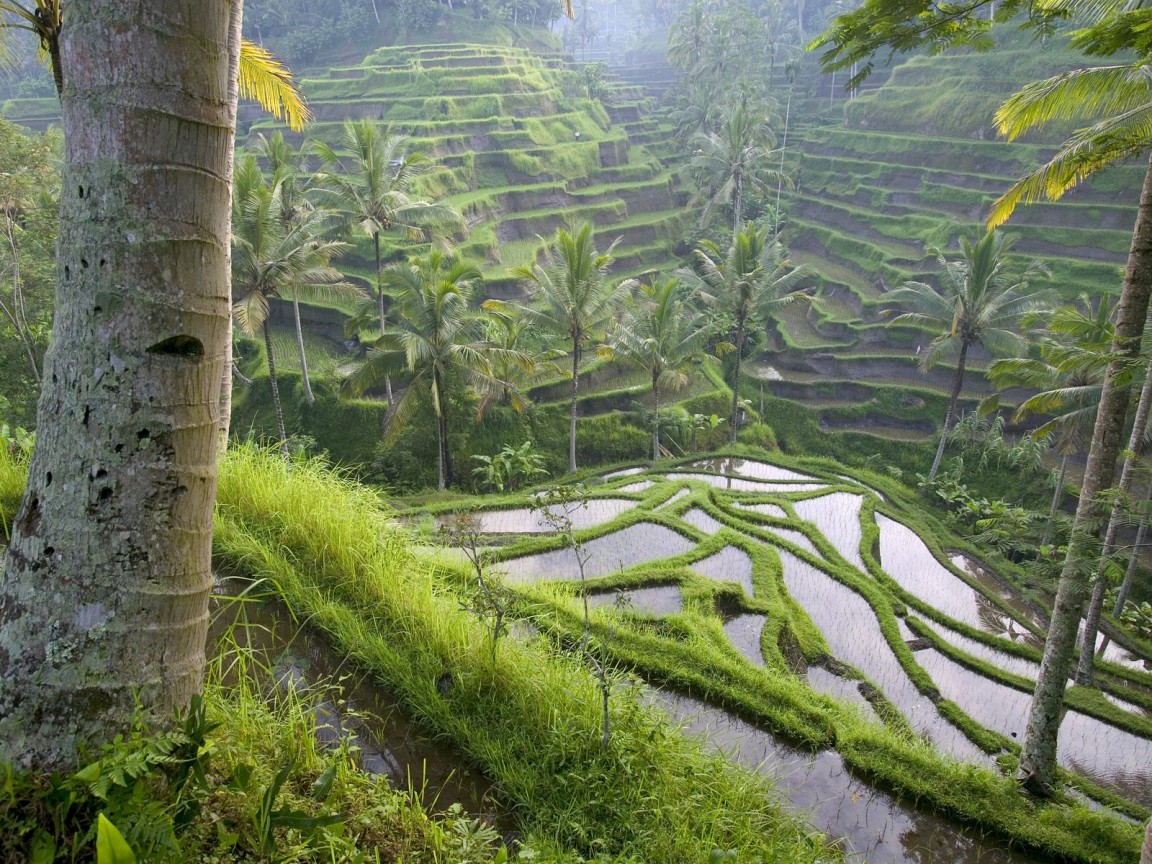Friday, June 26, 2009
Ngarai Sianok Tourism - West Sumatra
Bukittinggi (Indonesian for "high hill") is one of the larger cities in West Sumatra, Indonesia, with a population of over 91,000 people and an area of 25.24 km². It is situated in the Minangkabau highlands, 90 km by road from the West Sumatran capital city of Padang. It is located at [show location on an interactive map] 0°18′20″S 100°22′9″E / 0.30556°S 100.36917°E / -0.30556; 100.36917, near the volcanoes Mount Singgalang (inactive) and Mount Marapi (still active). At 930 m above sea level, the city has a cool climate with temperatures between 16.1°-24.9°C.
Thursday, June 25, 2009
Five Asmat Ancestor Figures

FIVE ASMAT ANCESTOR FIGURES
Left to right:
DOUBLE FIGURE, carved by Okaochino (active early 1960s) Amanamkal village ca 1961, wood, paint leaves. The Michael C. Rockefeller and Mrs Mary C. Rockefeller 1965 (1978.412.1156) Collected by Michael C. Rockefeller 1961.
DOUBLE FIGURE, Komor Village, mid 20th century, Wood paint, fiber and shell. The Michael C. Rockfeller Memorial Collection. Bequest of Nelson A. Rockfeller 1979 (1979.206.1590) Ex coll. Emden, Administrator for Netherlands New Guinea.
MALE FIGURE, Manu village, early to mid 20th century, wood paint, fiber, pig tuks, cassowary quills. The Michael C. Rockfeller Memorial Collection. Bequest of Nelson A. Rockfeller 1979 (1979.206.1589). Ex coll. Emden, Administrator for Netherlands New Guinea.
MALE FIGURE, carved by Ndojokor (active early 1960s)
ca. 1961 Wood paint.The Michael C. Rockfeller Memorial Collection. Gift of Nelson A. Rockfeller and Mrs Mary C. Rockfeller 1965. (1978.412.1155). collected by Michael C. Rockfeller 1961.
MALE FIGURE, Otsjanep village, ca. 1961, wood, paint, fiber, bamboo. The Michael C. Rockfeller Memorial Collection. Gift of Nelson A. Rockfeller and Mrs Mary C. Rockfeller 1965. (1978.412.1164). Collected by Michael C. Rockfeller, 1961.
Tuesday, June 23, 2009
Borobudur Temple

Borobudur is a ninth-century Mahayana Buddhist Monument in Magelang, Central Java, Indonesia. The monument comprises six square platforms topped by three circular platforms, and is decorated with 2,672 relief panels and 504 Buddha statues. A main dome, located at the center of the top platform, is surrounded by 72 Buddha statues seated inside perforated stupa.
The monument is both a shrine to the Lord Buddha and a place for Buddhist pilgrimage. The journey for pilgrims begins at the base of the monument and follows a path circumambulating the monument while ascending to the top through the three levels of Buddhist cosmology, namely Kāmadhātu (the world of desire), Rupadhatu (the world of forms) and Arupadhatu (the world of formlessness). During the journey the monument guides the pilgrims through a system of stairways and corridors with 1,460 narrative relief panels on the wall and the balustrades.
Evidence suggests Borobudur was abandoned following the fourteenth century decline of Buddhist and Hindu kingdoms in Java, and the Javanese conversion to Islam. Worldwide knowledge of its existence was sparked in 1814 by Sir Thomas Stamford Raffles, the then British ruler of Java, who was advised of its location by native Indonesians. Borobudur has since been preserved through several restorations. The largest restoration project was undertaken between 1975 and 1982 by the Indonesian government and UNESCO, following which the monument was listed as a UNESCO World Heritage Site. Borobudur is still used for pilgrimage; once a year Buddhists in Indonesia celebrate Vesak at the monument, and Borobudur is Indonesia's single most visited tourist attraction.
Legong Dance

In Hinduism, dance is an accompaniment to the perpetual dissolving and reforming of the world. The creative and reproductive balance is often personified as Shiva's wife, Durga, sometimes called Uma, Parvati, or Kali. This has significance in Balinese Hinduism, since the common figure of Rangda is similar in many ways to Durga. In Bali there are various categories of dance (i.e. barong, legong, kecak) including epic performances such as the omnipresent Mahabharata and Ramayana. Bali dancers learn the craft as children from their mothers as young as age 4 (see a nine years old dancer on the right). In Balinese dance the movement is closely associated with the rhythms produced by the gamelan, a musical ensemble specific to Java, Bali and Malaya. Multiple levels of articulations in the face, eyes, hands, arms, hips, and feet are coordinated to reflect layers of percussive sounds. The number of codified hand positions and gestures, the mudras, is higher in India than in Java or Bali. It has been speculated that they have been forgotten as the dance was transmitted from India to Java[8]. Hand positions and gestures are nonetheless as important in Javanese and Balinese dance as in India. Whether in India, Indonesia or Cambodia, hands have a typically ornamental role and emphasize the dance's delicate intricacy.
Bunaken Undersea

Bunaken is part of the Bunaken National Marine Park, which has some of the highest levels of marine biodiversity in the world.[citation needed] Scuba diving attracts many visitors to the island. Bunaken is located at the north of the island of Sulawesi, Indonesia. It belongs administratively to the municipality of Manado.
The Bunaken National Marine Park was formally established in 1991 and is among the first of Indonesia's growing system of marine parks. The park covers a total surface area of 890.65 km², 97% of which is overlain by sparkling clear, warm tropical water. The remaining 3% of the park is terrestrial, including the five islands of Bunaken, Manado Tua, Mantehage, Nain and Siladen. Although each of these islands has a special character, it is the aquatic ecosystem that attracts most naturalists.
Gamelan Jogja

Gamelan's role in rituals is so important that there is a Javanese saying that "It's not official until the gong is hung." Some performances are associated with royalty, such as visits by the sultan of Yogyakarta. Certain gamelans are associated with specific rituals, such as the Gamelan Sekaten, which is used in celebration of Mawlid an-Nabi (Muhammad's birthday). In Bali, almost all religious rituals include gamelan performance. Gamelan is also used in the ceremonies of the Catholic church in Indonesia. Certain pieces are designated for starting and ending performances or ceremonies. When a "leaving" piece (such as "Udan Mas") is begun, the audience will know that the event is nearly finished and will begin to leave. Certain pieces are also believed to possess magic powers, and can be used to ward off evil spirits.
Ronggeng Jakarta Dancer

His books have been published in Japanese, Chinese, Dutch and German. An English edition of Ronggeng Dukuh Paruk is being prepared for publishing with the University of Hawaii and the Lontar Foundation in Jakarta.
Komodo Island

Komodo is one of the 17,508 islands that make up the Republic of Indonesia. The island has a surface area of 390 km² and over 2000 inhabitants. The inhabitants of the island are descendants of former convicts who were exiled to the island and who have mixed themselves with the Bugis from Sulawesi. The population are primarily adherents of Islam but there are also Christian and Hindu minorities.
Komodo is part of the Lesser Sunda chain of islands and forms part of the Komodo National Park. Particularly notable here is the native Komodo dragon. In addition, the island is a popular destination for diving. Administratively, it is part of the East Nusa Tenggara province.
Grojogan Sewu Waterfall

Grojogan Sewu located at Karanganyar Regency, Grojogan sewu is one of tourism program that called "INTANPARI" ( Industri Pertanian Pariwisata ) it means Industry Botani and Tourism. Grojogan Sewu is located at Mount Lawu (2632 meter), the location are 27 kilo meter from Karanganyar Regency. Grojogan sewu means thousand waterfall. Although there is no thousand waterfall there, you still can enjoy some waterfalls there. The highest waterfall at Grojogan Sewu have 81 meter high from bottom to the top, the forest sight make this waterfall have tractive power for tourist.
Bali - Temple
![[Bali-temple-wallpaper-01-1280.jpg]](http://1.bp.blogspot.com/_-TWWQP_PwP0/SezLMhOU1II/AAAAAAAAALM/edKzGXbGjrc/s1600/Bali-temple-wallpaper-01-1280.jpg)
Bali has a number of important sea temples which were founded in the 16th century by a Majapahit monk from Java named Nirartha to honour the gods of the sea. Each of the temples is traditionally said to be visible from the next, forming a 'chain' around the coast of Bali. Many of the most important sea temples are along the south west coast of the island.
Monday, June 22, 2009
Ubud Bali

The main street is Jalan Raya Ubud (Jl. Raya means main road), which runs east-west through the center of town. Two long roads, Jalan Monkey Forest and Jalan Hanoman, extend south from Jl. Raya Ubud. Puri Saren Agung is a large palace located at the intersection of Monkey Forest and Raya Ubud roads. The home of Tjokorda Gede Agung Sukawati (1910-1978), the last "king" of Ubud, it is now occupied by his descendants and dance performances are held in its courtyard. It was also one of Ubud's first hotels, dating back to the 1930s.
Subscribe to:
Posts (Atom)

